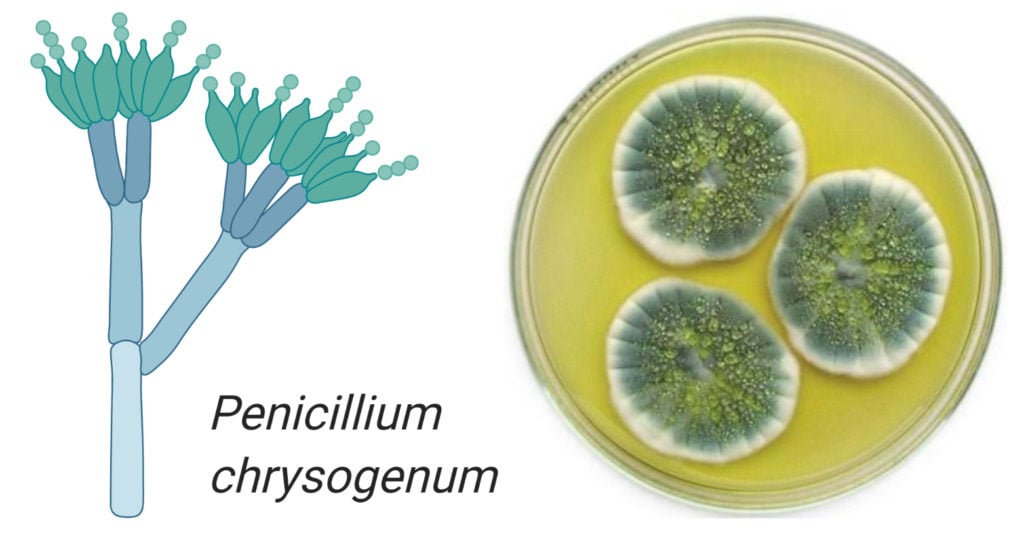
Figure: Penicillium chrysogenum. Image Source: Pinterest, created using biorender.com
- Penicillium chrysogenum is also known as Penicillium notatum, the first Penicillium fungi used for the isolation of penicillin antibiotics, which is used for the treatment of Gram-positive bacteria.
- It is also used in the production of other β-lactam antibiotics.
- It is an allergen and has pathogenic activity however it is uncommon in causing disease in humans.
- Incidences of opportunistic infections by P.chrysogenum have however been reported, causing infections in immune-compromised persons with underlying conditions.
- The name penicillium originates from Latin to mean painters brush because of the structure of the conidial spores which are fluffy in appearance.
Interesting Science Videos
Habitat of Penicillium chrysogenum
- It is found indoors, in areas that are humid, dump, or having dumped water.
- It is also very common in temperate and subtropical areas.
- It is found in moist soil and degraded forest vegetation.
- It is saprophytic hence it can also grow in the dead decayed matter.
- It also grows in stored food and damp building material, hence it is commonly an indoor fungus.
- It can also be found on alfalfa leafcutter bees and subglacial ice feeding on sediment-rich basal ice shelves.
- It can also be found on fruit causing decay.
Morphology of Penicillium chrysogenum
- Penicillium chrysogenum reproduces by forming dry chains of spores known as conidia, from a thread-like, brush shaped structure known as conidiophore.
- Microscopically, P. chrysogenum shows typical filamentous hyphae with conidia, which are the asexual spores of the fungi.
- The hyphae are colorless, slender, tubular, branched, and septate hyphae.
- The hyphae are formed from several threads of mycelium which can get intertwined into a hyphal network.
- Fron the hyphal network, the conidiophores originate as long thick tubes with a swelling at the top, known as vesicles.
- The vesicles produce the primary sterigmata from where the secondary sterigmata originate.
- The secondary sterigmata form the conidial spores.
- The conidia are long, cottony, or fluffy in texture.
Cultural characteristics of Penicillium chrysogenum
- Penicillium chrysogenum colonies appear blue-green in color with a yellowish pigment.
- Alexander Fleming described it as white fluffy mass” that later turns green then black. A yellow color appears after several days that will diffuse throughout the medium.
Life Cycle of Penicillium chrysogenum
- Penicillium chrysogenum reproduces asexually by producing asexual spores known as conidia.
- The conidial spores are released by wind or water or animals.
- They then land on a platform with the right growth and nutrient conditions, they start to germinate.
- During germination, they form mycelial threads known as hyphae.
- From the hyphae, conidiophore tubes are formed with a bulged vesicle at the top end.
- From the vesicles, primary sterigmata originate also known as phialides.
- The phialides form the conidial spores.
Pathogenesis of Penicilliun chrysogenum
- Penicillium chrysogenum causes disease on rare occasions and of which, if it causes an infection it is opportunistic in people with severely suppressed immune systems such as HIV/AIDS patients.
- It has a very low pathogenicity effect and therefore, identifying and detecting it in infection is very low. Symptoms of its infections include:
- Pulmonary infection i.e pneumonia, localized granulomas, fungus balls, and systemic infection.
- Systemic endophthalmitis, an inflammation of the ocular cavity.
- Inducing allergen and asthma, by activating histamine to the epithelial lining of the lungs which causes asthmatic symptoms.
Treatment on Penicillium chrysogenum infection
- Treatment is by surgical removal of the foci of the infection
- Use of oral antifungals such as amphotericin B and itraconazole.
- For systemic endophthalmitis, use of topical amphotericin B or itraconazole
Industrial Applications of Penicillium chrysogenum
- Scientists have exploited the competence of Penicillium chrysogenum in antibiotic production. The fungus produces a hydrophobic β-lactam compound known as penicillin.
- Penicillin, an antibiotic has been used in the treatment of gram-positive bacterial infections such as pneumonia, gonorrhea, wounds, staphylococcal infections, bacterial fevers.
- Penicillin structural variations classify it into two types, Penicillin G and penicillin V.
- Penicillin has also been used in the treatment of crop diseases in apples, trees, grapes, and tomatoes, inducing protective mechanism against infections
Prevention and Control
- Using water to spray off areas where the fungus is growing, to reduce spore spread into the air.
- Use bleaches and warm water to clean the walls.
References and Sources
- http://robdunnlab.com/projects/invisible-life/penicillium-chrysogenum/
- https://botit.botany.wisc.edu/toms_fungi/nov2003.html
- https://microbewiki.kenyon.edu/index.php/Penicillium_chrysogenum
- https://www.bustmold.com/resources/mold-library/penicillium-chrysogenum/
- https://en.wikipedia.org/wiki/Penicillium_chrysogenum

Hi, my name is Postinus, I learned that penicillium chrysogenum. Like moisture environment and our car are now installed Air conditioner in the filters of the car can attached this fungi spores and due to the Air conditioner moisture the fungi spores developed and be spread through AC Air. So I want to know easy can we make air quality with Ac install in our car and indoor.
i want to know the diseases penicillium chrysogenum causes in humans
I want to know that why penicillium chrysogenum is also called penicillium notary?
last name penicillium notatum
hello my name is maximiliano I am a producer of chasinados my problem is that I have a mold contamination in the sausage all worsened by high temperatures and humidity the mold is heavy white and then teal type Penicillium chrysogenum is harmful to health. How to avoid it?